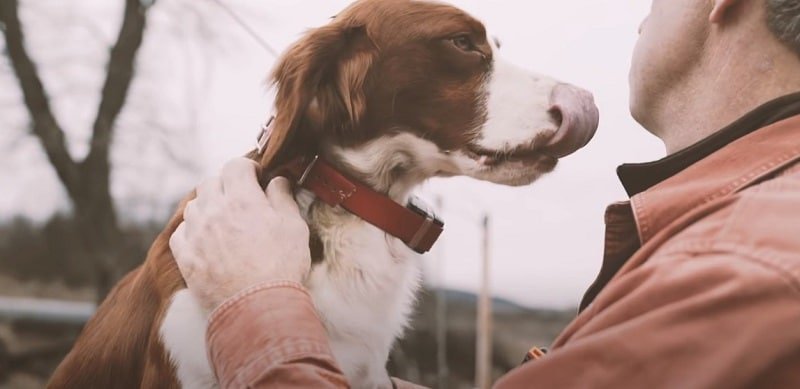Brittany Spaniels are famed for their short tails, while some breed members are born tailless. Therefore, it is acceptable for these dogs to have their tails docked. Docking is a procedure that involves removing a portion of a dog’s tail, and it explains why only a few Brittany Spaniels possess a tail longer than 4 inches.
Docking a tail may seem cruel and unnecessary to some. But, at the same time, the practice advocates believe that it is in keeping with the age-old tradition of preventing injury to the full tail of working/hunting dogs like the Brittany. Another reason Brittany dogs are docked is to conform to the breed’s standard, which is concerned with looks – especially important for show dogs.
People are often quite shocked to find out that these dogs are born with long tails, like many other breeds. Brittney’s are usually docked when they are a few days old.
However, now many vets prefer to perform the procedure when dogs are over eight weeks old to administer anesthesia, making it less painful for the dog. This article hopes to uncover more about the docking procedure, explaining how it is done and if the dogs feel pain.
It is essential to understand what is involved in docking a dog’s tail, as many owners will understandably have their reservations about it.
Do Brittany Spaniels Have Short Tails?
Most Brittany Spaniels are born with naturally long tails, even up to ten inches, while others are born with bobtail lines. These can appear as docked tails, but they are a biological phenotype. When Brittany Spaniels are a few days old, the breeder or vet docks their tail, so many Brittany Spaniels have a tail no longer than 4 inches.
Brittany Spaniels are first and foremost working dogs, and while many are companion pets, most people expect them to look a certain way; the traditional look is the typical working dog look, with a short tail.
Spaniel breeds have a thick tail shape at the base that begins to taper halfway down. Many consider the tail action of these dogs to be somewhat violent, where it can lead to a broken tail in the field, at the tail’s weak point.
The docking procedure is performed in one of two ways. The first method involves putting a rubber ligature on the tail to constrict the blood supply. It is left on for few days until the tail falls off. The second method involves severing the tail with a scalpel or with surgical scissors.
Apart from preventing injuries during baiting, ratting, and fighting, tail docking was believed to avoid rabies and strengthen the dog.
Nowadays, the procedure is used for cosmetic, prophylactic, and therapeutic purposes, and it is typically carried out by either veterinarians or breeders. Before dogs are docked, a veterinarian will give the puppy a complete health check-up and blood clot test.
Then, the dogs are tranquilized, put on their backs, and given general anesthesia. If puppies are under five days old, no general anesthesia is given.
The vet or breeder removes the non-absorbent sutures within seven days. On fully grown dogs, the tail’s base is bandaged and removed within three days.
The puppies or dogs are given an E-collar around their necks to stop them from paying attention to the area as it can hurt and itch.
Why Do They Cut Brittany’s Tails?
Historically, Brittany’s tails were docked for numerous reasons, but primarily to prevent injury when working in the field. These dogs mainly worked as gun dogs for bird hunting.
The first hunting description of Brittany Spaniels dates back to 1850 in the writings of Reverend Davies. He described them as “bobtailed” pointed dogs who were good at retrieving. Even back then, Brittany’s were expected to have short tails.
In the 1700s, taxation was applied to all dogs unless they were working dogs. The working dogs were consequently docked to tell them apart from non-working dogs. So, many owners cut the tails of their non-working dogs to avoid paying the tax.
In 1891, a book titled _The American Book of the Dog _glorified tail docking and ear cropping, touting them as the proper look for dogs. Also, in Ancient Rome, shepherds thought removing the top of a puppy’s tail on the fortieth day after birth prevented rabies.
While today, most Brittany’s are companion pets, some advocates of docking still claim that the procedure is about benefitting the dog and preventing injury to the tail.
This logic appears to be that you cannot injure a limb you don’t have. In addition, these advocates claim that it isn’t about appearances.
Tail docking is banned in numerous countries, including most of Europe and Australia. For example, the practice is banned in England and Wales except for dogs working in the armed services, law enforcement, and emergency rescue. A veterinary surgeon must remove the tails before puppies are five days old.
There is no such restriction in the United States and Canada, and many dog owners take it upon themselves to dock their dog’s tails.
However, tail docking is becoming increasingly unpopular, even in countries where it is legal. Animal welfare groups are opposed to cosmetic tail docking stating it to be pointless and compromising of the dog’s welfare.
It also carries medical risks like infections, incontinence, and agonizing regrowth of nerve tissue post-amputation, called neuromas.
When considering the health risks associated with tail removal, you have to question the validity of the practice today since most docked puppies are pets and not working dogs.
Thankfully, cosmetic docking is banned in many countries, so if you see docked adult dogs, the chances are that the tail was removed before the ban, or perhaps the dogs were born with bobbed tails.
Is It Cruel To Dock A Brittany Spaniels Tail?
Many reasons for tail docking seem unconvincing since many Brittany’s are pets and not working dogs. However, docking made sense at one time, as it was performed to prevent injuries as working dogs without tails were not likely to collect debris and dirt or feces around their rear end. In addition, Brittany’s were less likely to get caught in farm equipment, carts, and wagons.
No anesthesia is given to puppies before the age of five days old. Those in favor of tail docking claim it doesn’t hurt the dog or cause discomfort as the puppy’s nervous systems are not yet developed.
This claim is untrue as evidence reveals that a dog’s basic nervous system is fully developed at birth. Furthermore, puppies have the same sensitivity to pain as mature dogs.
The docking procedure involves cutting through tendons and muscles and about seven pairs of very sensitive nerves. Then, it severs cartilage and bone connections.
The surgery is done without anesthesia or pain relief. Puppies are heard giving intense screaming vocalizations when the tail is removed and the wounds are stitched. It appears that puppies feel severe pain when their tails are severed.
Tail docking causes damage and inflammation to the tissues, and it carries a risk of infection and other health issues such as neuromas at the amputation site. These are extremely painful.
Aside from the pain and distress the surgery causes, dogs lose an essential communication tool. The movement of the dog’s tails indicates warning signals, submission, friendliness, and a desire to play. This appendage serves as a protective mechanism, and it can help to avoid aggression and establish boundaries.

Dogs can also use their tails to convey messages to humans. It can help owners understand a dog’s body language and decide what course of action is appropriate in a particular situation.
Removing a dog’s tail undoubtedly impairs their ability to communicate adequately, and it leaves them vulnerable to being misunderstood by humans and other dogs, putting them at a social disadvantage.
Dogs also use their tails for the following reasons:
- Provide balance
- To keep insects off
- To help them swim better
- To conserve body heat. When dogs are cold, they will curl into a ball and wrap their tails over their faces
Tails should not be removed unless for therapeutic reasons. However, there is hope for dogs as many vets in the United States refuse to perform the cosmetic procedure on dogs. They only agree to dock tails if there is an injury or medical reason for the surgery.
Final Thoughts
Tails are essential communication tools in a dog’s world, and it seems cruel and unfair to take away such an important canine social role. Tails reveal so much about a dog to other dogs and humans, so it makes no sense to place them at such a social disadvantage. While many vets and breeders are against docking, some favor the practice and want to bring it back in countries where it’s illegal.
Tail docking has its place in history, and those who did it had good intentions. However, dogs were not popular as pets. They were used to assist humans in hunting, herding, retrieving, etc., and tail bones could be broken upon impact in the field. If your Brittany’s tail gets injured, there are ways to treat that; there is no need to amputate.
Table Of Content
